In today’s competitive digital landscape, knowing how to check competitors email marketing campaigns is essential for staying ahead. By analyzing what your competitors are doing with their email strategies, you can uncover valuable insights that help you refine your own campaigns. Whether it’s understanding their subject lines, email sequences, or automation, competitor analysis can guide your strategy to boost engagement and conversions. In this post, we’ll explore how to effectively monitor and learn from your competitors’ email marketing efforts.
Why Analyze Competitors’ Email Marketing Campaigns?
Understanding how to check competitors’ email marketing campaigns is a powerful way to sharpen your own strategy. By analyzing what other brands in your niche are doing, you can uncover valuable insights that help you improve engagement, increase conversions, and stay ahead of the curve.
1. Discover What Works in Your Industry
Analyzing your competitors’ campaigns helps you identify trends in subject lines, content structure, and send times. If multiple successful brands are using a similar approach, it’s likely resonating with the audience.
2. Learn from Their Mistakes
By evaluating poor-performing or spammy-looking emails, you can avoid making the same mistakes in your own campaigns—like overuse of promotions, poor mobile design, or unclear calls to action.
3. Get Content and Design Inspiration
Competitor emails can serve as a swipe file for your own marketing efforts. Whether it’s their header design, CTA placement, or use of personalization, there’s a lot to learn and adapt.
4. Identify Gaps and Opportunities
When you regularly monitor competitors, you can spot areas where they’re falling short—like not using automation, missing welcome emails, or ignoring certain content types. This opens the door for your brand to fill the gap.
5. Stay Competitive
Email marketing is a fast-moving space. Keeping tabs on others ensures you’re not left behind when new trends or tactics emerge.
What to Look for in Competitors’ Email Campaigns
Once you understand how to check competitors’ email marketing campaigns, the next step is knowing exactly what to analyze. Simply collecting emails isn’t enough—you need to look at key elements that reveal how competitors engage, convert, and retain their audience.
1. Subject Lines
Subject lines are the first thing subscribers see. Take note of the tone, length, use of emojis, personalization, and urgency. Are they using questions? Are they offering discounts?
2. Sender Name and Email
Check whether they send emails from a person’s name, a company name, or both. This affects open rates and trust.
3. Email Frequency and Timing
How often are they sending emails—daily, weekly, or monthly? What time of day do their emails land in your inbox?
4. Content Type
Do they send newsletters, product updates, blog posts, or promotional offers? Understanding their content mix gives clues about their goals.
5. Personalization Tactics
Look for how they personalize emails—do they include your name, location, or recommend products based on previous behavior?
6. Design and Layout
Examine their email structure. Are they image-heavy or text-based? Is the layout mobile-responsive? Clean and minimal, or bold and flashy?
7. Call-to-Action (CTA)
Analyze the placement, style, and wording of their CTAs. Are they using buttons or links? Do they create urgency?
8. Promotions and Offers
Check if they use discounts, limited-time deals, or loyalty incentives. How often do they push sales messages?
9. Branding and Tone of Voice
Assess whether their emails match their website and overall brand identity. Is the tone friendly, formal, humorous, or authoritative?
10. Unsubscribe Process
Finally, see how easy or difficult it is to unsubscribe. A well-designed process may indicate user respect and compliance with email regulations.
Best Tools to Check Competitors’ Email Marketing Campaigns
If you’re wondering how to check competitors’ email marketing campaigns effectively, using the right tools can save you time and provide deep insights. Below are some of the best tools available to monitor and analyze your competitors’ email strategies.
1. Mailcharts
Mailcharts is a popular platform that collects and analyzes emails from thousands of brands. You can explore competitors’ full email journeys, including automation flows, frequency, subject lines, and more.
2. Milled
Milled is a free archive of promotional emails from thousands of brands. Simply search by company name or keyword to see recent email examples.
3. Owletter
Owletter captures emails from your competitors’ websites and automatically categorizes and analyzes them over time. It helps spot trends in timing, content, and frequency.
Best for: Ongoing monitoring and alerts on changes in email activity
4. Similarweb
While not specifically an email tool, Similarweb gives insights into a competitor’s traffic sources, which may include email as a traffic driver. If you see spikes in direct traffic, it could be linked to email campaigns.
Best for: Big-picture competitive analysis, including email’s impact
5. BuiltWith
BuiltWith can help you discover which email marketing platforms a competitor is using (e.g., Mailchimp, Klaviyo, ConvertKit). This gives clues about their tech stack and potential automation capabilities.
6. SendView
SendView lets you sign up to receive and analyze emails from specific competitors in one clean inbox. It tracks key metrics like subject lines, CTAs, and send times.
Best for: Personal inbox-style tracking with performance insights
7. Competitor Email Inbox (Manual Tracking)
Create a dedicated email account and sign up for your competitors’ newsletters. This old-school but effective method lets you personally observe their strategy over time.
Using one or more of these tools makes checking competitors’ email marketing campaigns much more manageable and data-driven.
How to Sign Up for Competitors’ Newsletters (Legally)
When it comes to how to check competitors’ email marketing campaigns, one of the most direct methods is simply signing up for their newsletters. This is a legal and effective way to monitor what your competitors are sending out and to gain insights into their email strategies. Here’s how to do it properly.
1. Create a Dedicated Email Account
It’s essential to have a separate email address specifically for competitor analysis. This keeps your personal inbox clean and avoids potential spam issues. Use services like Gmail or Outlook, or create a unique domain email if you prefer.
2. Sign Up on Competitor Websites
Visit your competitors’ websites and look for their newsletter sign-up forms. These are usually located at the bottom of the homepage, in pop-ups, or on product pages. Ensure you’re subscribing to their email list in a way that allows you to receive regular campaign updates.
3. Use a Catch-All Email Address for Multiple Competitors
If you’re tracking multiple competitors, consider using a catch-all email address. Services like Google’s Gmail allow you to add a “+” sign and any identifier after your email username (e.g., competitor1+email@gmail.com). This helps you organize and filter emails from different brands.
4. Subscribe to Relevant Email Lists
Many competitors have multiple lists or options for different types of emails. Choose the most relevant lists for your analysis, such as newsletters, product updates, or promotional campaigns. Opting in for all available lists ensures you don’t miss any campaign types.
5. Be Careful with Personal Data
While signing up for competitor emails is completely legal, avoid providing unnecessary personal information unless required. Always check if the competitor is asking for more than what’s needed for signing up for their newsletter (e.g., excessive personal info).
6. Unsubscribe When Necessary
After you’ve gathered enough data or if the email frequency becomes overwhelming, unsubscribe from the newsletters. This is an essential step in maintaining ethical practices and not becoming too involved with their brand promotions.
By following these steps, you can legally subscribe to your competitors’ email lists and gain insights into their strategies. This method helps you stay compliant with privacy laws and ensures you’re not crossing any ethical lines while learning from their email marketing campaigns.
Understanding Automation and Sequences
When learning how to check competitors’ email marketing campaigns, it’s crucial to understand email automation and sequences. These elements are essential parts of most successful email marketing strategies, as they help create a consistent, personalized experience for subscribers without manual intervention. Here’s what you need to know.
1. What Are Email Sequences?
Email sequences are pre-designed series of emails sent automatically to subscribers based on specific triggers or actions. These sequences often aim to nurture leads, onboard new customers, or drive specific actions like purchases or engagement.
For example, a common email sequence is the welcome series, where new subscribers receive a series of emails introducing them to the brand, its products, and special offers.
2. Identifying Automation in Competitors’ Emails
When you’re checking competitors’ email campaigns, pay attention to any signs of automation. Look for patterns in how emails are sent, such as:
- Emails sent after a certain period of time
- Triggered responses after specific user actions (e.g., abandoned cart emails)
- Follow-up sequences that feel personalized but are automated
By identifying these triggers, you can gain insights into the timing and structure of their email automation strategy.
3. Common Types of Email Sequences
Competitors may use different types of email sequences, such as:
- Welcome Emails: Sent immediately after someone subscribes to their list.
- Abandoned Cart Emails: Triggered when a user adds items to their cart but doesn’t complete the purchase.
- Product or Service Onboarding: Series of emails designed to guide a new customer through using their product or service.
- Re-engagement Emails: Sent to re-engage inactive subscribers with special offers or incentives.
4. How to Detect Sequences in Competitors’ Emails
To identify automation in your competitors’ campaigns:
- Look at the timing of their emails. Are they spaced out consistently?
- Observe if emails are personalized based on your behavior or preferences (e.g., product recommendations, first-name usage).
- Sign up for multiple competitor lists to see if their sequences follow similar patterns.
5. Why Automation Matters
Email automation saves time while delivering a more personalized experience to the subscriber. It also increases engagement by sending relevant content at the right time, which can lead to higher conversion rates.
Understanding your competitors’ automated email systems allows you to adopt similar strategies, or even better ones, in your own campaigns. By leveraging automation, you can provide a seamless customer experience and improve your marketing ROI.
By keeping an eye on your competitors’ automation and email sequences, you can identify successful strategies and replicate them in your own campaigns.
Common Mistakes When Monitoring Competitor Campaigns
While learning how to check competitors’ email marketing campaigns can provide valuable insights, it’s easy to fall into common traps that can hinder your analysis. Avoid these mistakes to ensure you’re getting the most out of your competitor research.
1. Overanalyzing Without Taking Action
One of the biggest mistakes is getting caught up in the details without applying what you’ve learned. It’s important to analyze competitors’ strategies, but you need to take action and adapt your findings to improve your own campaigns.
2. Focusing Only on Big Competitors
It’s easy to focus your attention on the biggest players in your industry, but don’t overlook smaller competitors who might be using innovative strategies or targeting niche audiences. Smaller brands may offer unique insights that big brands overlook.
3. Copying Competitor Campaigns Too Closely
While it’s fine to learn from your competitors, copying their campaigns exactly can backfire. Your audience is unique, and copying content, subject lines, or offers may make your emails feel inauthentic. Always adapt strategies to fit your brand and voice.
4. Ignoring Frequency and Timing
Just because a competitor sends emails daily or weekly doesn’t mean you should too. It’s essential to analyze their email frequency and the timing of their campaigns, but your audience may prefer less frequent emails or different send times. Avoid blindly following their schedule.
5. Failing to Account for Different Audiences
Not all competitors target the same audience. They might be using a different tone, offers, or product focus based on their customer base. Make sure you’re not comparing campaigns that are targeting different segments or demographics, as this could lead to misleading conclusions.
6. Neglecting Legal and Ethical Boundaries
While learning from competitors is fine, remember that copying or using their content directly (without permission) is a breach of copyright and ethical marketing practices. Always ensure your research is used for inspiration, not duplication.
7. Not Tracking Long-Term Trends
Competitor email marketing campaigns change over time. Don’t just monitor their emails for a short period and assume you have the full picture. Track their campaigns over weeks or months to identify long-term trends and strategies that consistently perform well.
8. Overlooking Mobile Optimization
If you’re not paying attention to how competitors design their emails for mobile devices, you’re missing a crucial detail. Mobile optimization is essential for engagement, and failing to check if competitors are using responsive designs could leave you behind.
By avoiding these common mistakes, you can gain a clearer and more actionable understanding of how to check competitors’ email marketing campaigns. This allows you to refine your own email strategy and ensure you’re implementing the best practices for your audience.
Conclusion
Learning how to check competitors’ email marketing campaigns is a critical step in improving your own email strategy. By understanding what your competitors are doing, you can uncover valuable insights, spot trends, and avoid costly mistakes. The key is to focus on the right elements—subject lines, automation, design, and personalization—while ensuring you stay ethical and compliant with legal boundaries.
Remember, simply analyzing competitors is not enough; you need to apply what you learn to your own campaigns. Whether you’re looking to refine your email content, improve engagement, or implement more effective automation, competitor research can guide you toward better decisions.
Stay consistent with your analysis, adapt strategies to suit your unique audience, and continue evolving your email marketing efforts. By doing so, you’ll stay ahead of the competition and achieve higher success with your campaigns.




![Read more about the article How to Start Affiliate Marketing as a Complete Beginner [2025 Guide]](https://prograte.tech/wp-content/uploads/2025/05/How-to-Start-Affiliate-Marketing-as-a-Complete-Beginner-2025-Guide-300x188.webp)